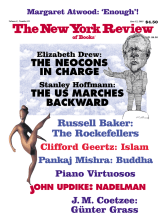To the Editors:
I was surprised to read in the excellent introductory overview of the life and work of Isaac Babel by John Bayley that “an American pilot called Major Fauntleroy…was one of the mercenary adventurers flying Spads and Camels for the White general Wrangel and his army” [NYR, April 11, 2002]. This misattribution seems particularly ironic since Bayley’s article appeared next to Neal Ascherson’s equally excellent review of the life and work of Marcel Reich-Ranicki. Ascherson is one of the two leading British experts on the Polish–Soviet War of 1919–1921; the other is Norman Davies. (See Neal Ascherson, The Struggles for Poland, London: Michael Joseph, 1987; and Norman Davies, White Eagle, Red Star: The Polish–Soviet War, 1919– 1921, London: Macdonald, 1974.)
Though the leading “Red” general Mikhail Tukhachevsky liked to refer to “White Poland” and the “Polish Whites,” the “Whites” properly were Russians who supported the ancien regime. The Poles under Pilsudski refused to cooperate with the Whites against the Bolsheviks because the Whites (led by Deniken, then Wrangel) were tsarists who wanted to preserve the Empire, including its Polish segment. Pilsudski’s primary aim was the restoration of a sovereign independent Poland, which he achieved by his victory over Tukhachevsky’s forces at Warsaw on August 15, 1920. I can’t resist observing, with a smile, that the Polish red and white (the national colors) were restored against the background of the war between the Reds and Whites.
Major Cedric E. Fauntleroy was the leader of
a group of volunteer American pilots who formed an escadrille and fought and flew for Poland in the Polish–Russian War of 1919–1920 [sic]. They called themselves the Kosciuszko Squadron in honor of the 30 year old Polish Officer who served the cause of freedom during the American Revolutionary War [Saratoga, West Point, etc.]. Captain Merian C. Cooper conceived the idea of the squadron and Major Cedric E. Fauntleroy was its first commanding officer.
(Back dust jacket, Robert F. Karolevitz and Ross S. Fenn, Flight of Eagles: The Story of the American Kosciuszko Squadron in the Polish–Russian War 1919–1920, Sioux Falls, S.D.: Brevet Press, 1974)
We can recall the (reported) proclamation of the famed American volunteer Escadrille Lafayette on its arrival in France during World War I: “Lafayette, we are here!”
I doubt that John Bayley intended it, but to refer to Major Fauntleroy as a “mercenary” dishonors a truly noble, generously altruistic human, of which we humans have too few.
Robert P. Pula
Director Emeritus
Institute of General Semantics
Sykesville, Maryland
John Bayley replies:
I was glad to read Robert P. Pula’s letter and must apologize for my error about Major Fauntleroy and his fliers. The mistake effectively was that of Babel, not, I suspect, the most reliable of reporters, who habitually seemed to confuse Russian Whites with the Red Army’s purely Polish opponents. So Dr. Pula’s interesting and informative letter clears the matter up.
This Issue
June 12, 2003



